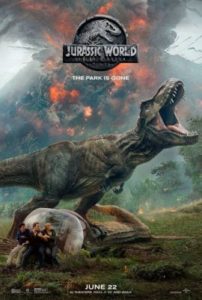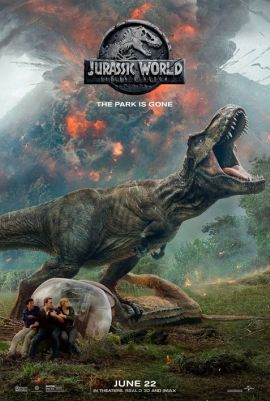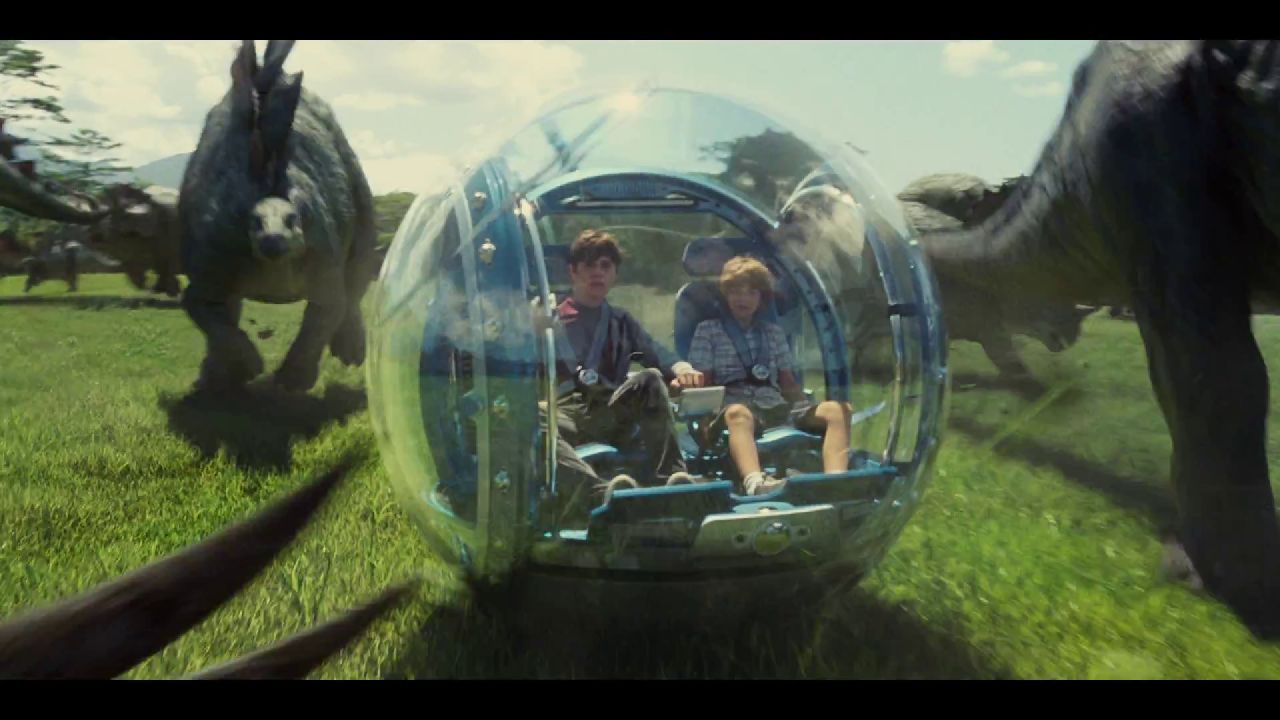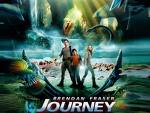Jurassic World: Fallen Kingdom
Posted on June 21, 2018 at 3:30 pm
B| Lowest Recommended Age: | Middle School |
| MPAA Rating: | Rated PG-13 for intense sequences of science-fiction violence and peril |
| Profanity: | Mild language |
| Alcohol/ Drugs: | None |
| Violence/ Scariness: | Extended and intense sci-fi/action peril and violence with many characters injured, eaten, gored, and killed, volcano, |
| Diversity Issues: | None |
| Date Released to Theaters: | June 22, 2018 |
| Date Released to DVD: | September 17, 2018 |

“Jurassic World: Fallen Kingdom” is a mildly entertaining but utterly unnecessary fifth in the series inspired by doctor-turned blockbuster author Michael Crichton’s books.
It does recognize that if you’re going to keep making movies about reconstituted dinosaurs, it’s time to get them off that island. Yes, I remember they made it to San Diego in #2, but by now we feel we know every leaf and tree on the island that was once the theme park created by twinkly-eyed, mega-rich John Hammond (Richard Attenborough) with the help of scientist of questionable ethics Dr. Henry Wu (B.D. Wong), where so, so many things have gone wrong, as Dr. Ian Malcolm (Jeff Goldblum) way back in the OG “Jurassic Park” back in 1993. He predicted that the results would be unpredictable, and not in our favor: “Yeah, but your scientists were so preoccupied with whether or not they could that they didn’t stop to think if they should.”
Dr. Malcolm is back again as this film begins, and he’s still not on board with dinosaurs existing at the same time as humans. He’s testifying at a Congressional hearing because the island has a retconned volcano eruption and if the world does not save them, all of the dinos will be wiped out. “Let it happen,” says Dr. Malcolm. That’s nature, and it will prevent them from wiping us out. But of course there are those who consider the dinos, however created, an endangered species now, and are trying to raise money to save them. This includes former all-business, now all-love-for dinos Claire Dearing (Bryce Dallas Howard, thankfully out of the stilettos and able to run in flats), paleovetrenarian Zia Rodriguez (Daniella Pineda), and, of course, this movie’s house computer whiz and full-time scardy-cat, hacker Franklin Webb (Justice Smith of “Paper Towns”).
Just when it seems all is lost, Claire gets the dream offer from retconned former Hammond partner and ailing ultra-rich guy Benjamin Lockwood, who lives with his young granddaughter Maisie (excellent screamer Isabella Sermon). If she can persuade former love interest Owen (Chris Pratt) to help her extract samples of different species, Noah-style, he will put them in an isolated compound where they will never bother anyone or be bothered by anyone ever again.
Yeah, you know what Dr. Malcolm would say about that. He’d also say, “Never trust a rich guy, or, maybe, trust a rich guy but never trust his henchmen who want very, very, very much to be rich guys, especially after Dr. Wu shows up again, plus Buffalo Bill from ‘Silence of the Lambs.'” About that, though. Rafe Spall and Toby Jones use their best American accents for the evil want-to-be-rich roles but they are pretty bad at business. They accepted how much per dino?
So, basically, this is a movie of dinosaurs on the island running away from a volcano while humans run away from the dinosaurs (Remember — you don’t have to be faster than the dinosaurs. You just have to be faster than some other humans.), followed by humans running away from dinosaurs and evil humans at Lockwoods cool, creepy, Victorian mansion, followed by, oh yes, a big fat cliffhanger. Get ready for #6, “Jurassic World: Electric Blue-galoo.”
Here’s what’s good. Director J.A. Bayona knows how to tell a story with a camera, and the film is well-paced and stylishly told. The original had Spielbergian magic in the story-telling as well as the special effects, though. This one is several orders of magnitude down the evolutionary scale, so to speak, on both counts.
Parents should know that this film has constant sci-fi action and peril, scary animal attacks, volcano, characters injured and killed, including being gored and being eaten, murder, sad death, and guns.
Family discussion: Who was right about rescuing the dinosaurs? Do you agree that we keep creating technology we are not capable of controlling?
If you like this, try: the other Jurassic Park/World movies and the book by Michael Crichton




